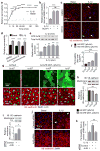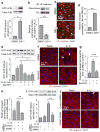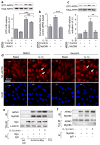Interleukin receptor activates a MYD88-ARNO-ARF6 cascade to disrupt vascular stability
- PMID: 23143332
- PMCID: PMC3521847
- DOI: 10.1038/nature11603
Interleukin receptor activates a MYD88-ARNO-ARF6 cascade to disrupt vascular stability
Abstract
The innate immune response is essential for combating infectious disease. Macrophages and other cells respond to infection by releasing cytokines, such as interleukin-1β (IL-1β), which in turn activate a well-described, myeloid-differentiation factor 88 (MYD88)-mediated, nuclear factor-κB (NF-κB)-dependent transcriptional pathway that results in inflammatory-cell activation and recruitment. Endothelial cells, which usually serve as a barrier to the movement of inflammatory cells out of the blood and into tissue, are also critical mediators of the inflammatory response. Paradoxically, the cytokines vital to a successful immune defence also have disruptive effects on endothelial cell-cell interactions and can trigger degradation of barrier function and dissociation of tissue architecture. The mechanism of this barrier dissolution and its relationship to the canonical NF-κB pathway remain poorly defined. Here we show that the direct, immediate and disruptive effects of IL-1β on endothelial stability in a human in vitro cell model are NF-κB independent and are instead the result of signalling through the small GTPase ADP-ribosylation factor 6 (ARF6) and its activator ARF nucleotide binding site opener (ARNO; also known as CYTH2). Moreover, we show that ARNO binds directly to the adaptor protein MYD88, and thus propose MYD88-ARNO-ARF6 as a proximal IL-1β signalling pathway distinct from that mediated by NF-κB. Finally, we show that SecinH3, an inhibitor of ARF guanine nucleotide-exchange factors such as ARNO, enhances vascular stability and significantly improves outcomes in animal models of inflammatory arthritis and acute inflammation.
Figures




Comment in
-
A new path to treating arthritis?Nat Rev Rheumatol. 2013 Jan;9(1):2. doi: 10.1038/nrrheum.2012.209. Epub 2012 Nov 27. Nat Rev Rheumatol. 2013. PMID: 23183926 No abstract available.
References
-
- Li Q, Verma IM. NF-kappaB regulation in the immune system. Nature reviews. Immunology. 2:725–734. - PubMed
-
- Collins T, et al. Transcriptional regulation of endothelial cell adhesion molecules: NF-kappa B and cytokine-inducible enhancers. FASEB J. 1995;9:899–909. - PubMed
-
- Liu SF, Malik AB. NF-kappa B activation as a pathological mechanism of septic shock and inflammation. Am J Physiol Lung Cell Mol Physiol. 2006;290:L622–L645. - PubMed
-
- RothwARF DM, Karin M. The NF-kappa B activation pathway: a paradigm in information transfer from membrane to nucleus. Sci STKE. 1999:RE1. - PubMed
-
- Pober JS, Sessa WC. Evolving functions of endothelial cells in inflammation. Nature reviews Immunology. 2007;7:803–815. - PubMed
Publication types
MeSH terms
Substances
Grants and funding
LinkOut - more resources
Full Text Sources
Other Literature Sources
Molecular Biology Databases

